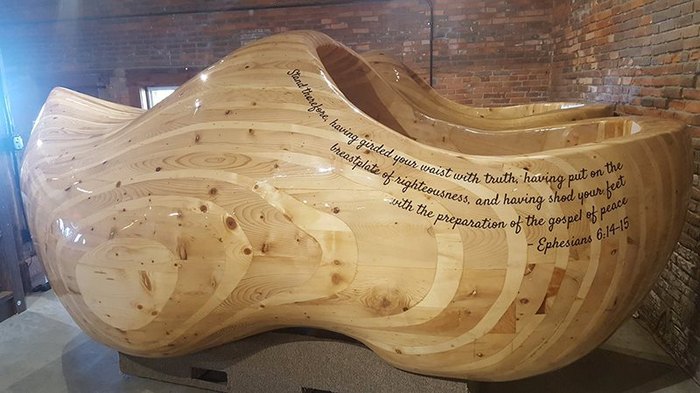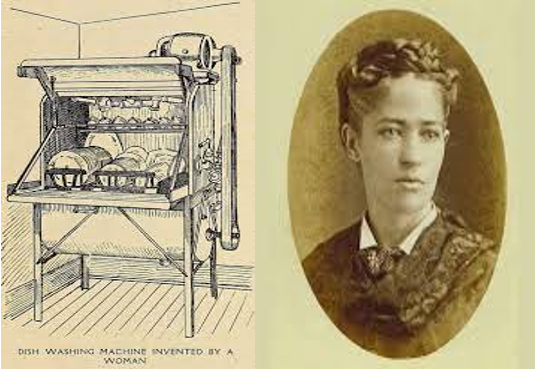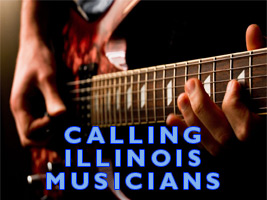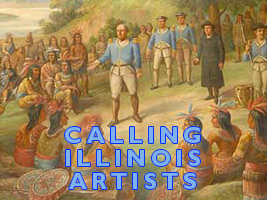- Details

Illinois is home to the first Ferris wheel, Abraham Lincoln’s house and “The Bean” in Chicago, but did you know Illinois also contains some amazing, and less well-known, tourist attractions? When driving around our great state, one can come across some cool and peculiar things that will definitely make you want to stop and take a look. Illinois has 10 larger than life attractions that everyone should go see when they have the chance.
Of these attractions is the world’s largest rocking chair, a statue of the world’s tallest man, Robert Wadlow (who was born in Illinois), the largest bottle of ketchup, the world’s largest wind chime and the world’s largest wooden shoes! Looking to send mail? In Illinois you can also find the world’s largest mailbox. Illinois truly does have attractions that are larger than life. If we ever need to host a giant, we will be prepared. The wooden shoes featured above are 11.5 feet long and 5.5 feet wide.
To read more about the 10 larger than life attractions every Illinoisan needs to see, click here.
- Details
 There’s some fun monkey business going around the Sock Monkey Museum in Long Grove. Established in 2019, the museum holds thousands of sock monkeys that have been collected by owners since 2006. Whether they were donated, from estate sales, garage sales, antique stores, previously amassed collections, heartwarming gifts, or purchased from the internet, the collection needed an entire building of its own.
There’s some fun monkey business going around the Sock Monkey Museum in Long Grove. Established in 2019, the museum holds thousands of sock monkeys that have been collected by owners since 2006. Whether they were donated, from estate sales, garage sales, antique stores, previously amassed collections, heartwarming gifts, or purchased from the internet, the collection needed an entire building of its own.
The collection continues to expand, as more Sock Monkeys find their way to the Museum. For the last 16 years, the museum has been fortunate to discover over 2,000 sock monkeys. In addition to housing sock monkeys, the museum also offers events where you can make your own sock monkey in remembrance of your trip. The origin of sock monkeys was even in Rockford.
John Nelson settled in Rockford in 1857 and formed the Nelson Knitting Company in 1880. They produced what they called “Celebrated Rockford Hosiery” and sold them under the name of the “Nelson Sock”. Production of these brown socks with the tan toe, heel and top, reached 450 dozen pair per day in 1904. In 1932, the Nelson Knitting Company added the trademark red heels to their durable work socks to distinguish them from their competitor’s.
During the Great Depression, money was scarce, so families found ways to make things at home, including toys for their children, with items they already had. Cutting and sewing a pair of worn out work socks, they created their own Sock Monkey dolls. They stuffed them with what they had on hand at home, such as sawdust, foam, rice, or nylons and decorated them to their own liking to make them unique. The red heels became the mouth and bottom of each sock monkey, and from there the famed sock monkeys rose to popularity.
- Details
 Hiss hiss, we got a new state snake here in Illinois! The Eastern Milksnake is our new state snake effective Jan. 1 thanks to a very dedicated seventh grader, Gentry Heiple, a student at Carterville Junior High School. The seventh grader researched the snake to promote his passion of snakes and highlight their importance.
Hiss hiss, we got a new state snake here in Illinois! The Eastern Milksnake is our new state snake effective Jan. 1 thanks to a very dedicated seventh grader, Gentry Heiple, a student at Carterville Junior High School. The seventh grader researched the snake to promote his passion of snakes and highlight their importance.
The legislation that made it official was HB 4821, which was sponsored by State Senators Mike Simmons and Patrick Joyce last year.
The Eastern Milksnake is prominent throughout the state, mainly living in fields, hills, rivers and woodlands. Though it looks similar to the copperhead snake, it actually is not poisonous and can even be kept as a pet. Typically the snake can be found in more northern regions in Illinois, whilst the red milksnakes are found in the southern regions. Their name came from the rumor that the snake could milk cows, which was started by farmers to evade the low volume of milk produced by their dairy cows.
Heiple grew interest in snakes due to the Shawnee National Forest being located near his hometown. For the last 50 years, a 2.5-mile segment of Forest Service Road No. 345, also known as Snake Road, is the only known place in the world to have an annual snake-related road closure for spring snake and amphibian migration in mid-March to mid-May for the spring snake migration and in September and October in the fall.
- Details

Cochran received the first U.S. patent for her commercially successful dishwasher on Dec. 28, 1886. She later unveiled her invention at the 1893 Chicago World’s Fair. She expected the invention to take to homes immediately. However, at first only restaurants and hotels were interested by her idea, and it was not until the 1950s when dishwashers became popular accessories for American homes.
Her invention had dishes fit in compartments in a wheel that turned inside a copper boiler. It was no surprise Cochran was able to come up with a brilliant idea, as she was born into a family of inventors. Her grandfather was awarded the patent for the steamboat. She built her prototype for the machine alongside mechanic George Butters. Eventually, her invention led to the creation of the company that would later be known as KitchenAid. For her invention, Josephine Cochran was inducted into the Inventors Hall of Fame in 2006.
Cochran built her prototype in Shelbyville and unveiled it at the Chicago World’s Fair. She succeeded in her goal of helping the American housewife, even if it took a few decades for the idea to take off in American households. A common household appliance and its inventor can trace their origins back to Illinois.
- Details

There is roughly 85 or more contestants in the parade that compete for the best novelty unit, best overall unit, best new entry, best commercial float entry, best non-profit float entry, and best religious float entry – this year’s theme being “Winter Wonderland.” A common tradition that the parade has followed is being right after Thanksgiving to kick off the upcoming winter holiday season with an average of 50,000 parade watchers attending.
The first parade in 1887 originally had boats and derricks sailing down the river as a celebration of the beginning of the new Upper Free bridge construction. However, the year after, the city decided to hold a parade through town, celebrating the completion of the bridge. The following year, Frederick Block of the Schipper and Block Department Store (later renamed Block & Kuhl's) sponsored a parade that followed the same route and featured Santa Claus. The parade was then first televised in 1958.This concept created the department-store sponsored parades that are currently popular at every Thanksgiving and Christmas in America. Talk about iconic! In addition to the parade attractions, there was also fireworks, occasionally a circus performance as well as the adored live reindeer exhibit.
During the first 72 years of the parade, its sponsorship by the Schipper and Block Department Store of Peoria had grown the event to 3,000 parade participants and included a 43-pipe calliope, fireworks and floats constructed by store employees and volunteers. The parade during this time ended with Santa climbing a fire escape ladder and disappearing through a window into the store’s toy department. Downtown Peoria truly is a site to see around the holidays, and having the longest-ran Santa parade makes it the perfect spot to visit to get into the festive spirit.
More Articles …
- Did you know? Many popular movies were filmed in Illinois
- Did you know? The first American woman to win a Nobel Peace Prize is from Illinois
- Happy Birthday Illinois! Illinois became a state on Dec. 3, 1818
- Did you know? Chicago had its own Spiderman
- Did you know? Legend says on Nov. 21, 1864 Lincoln wrote to a Civil War widow





